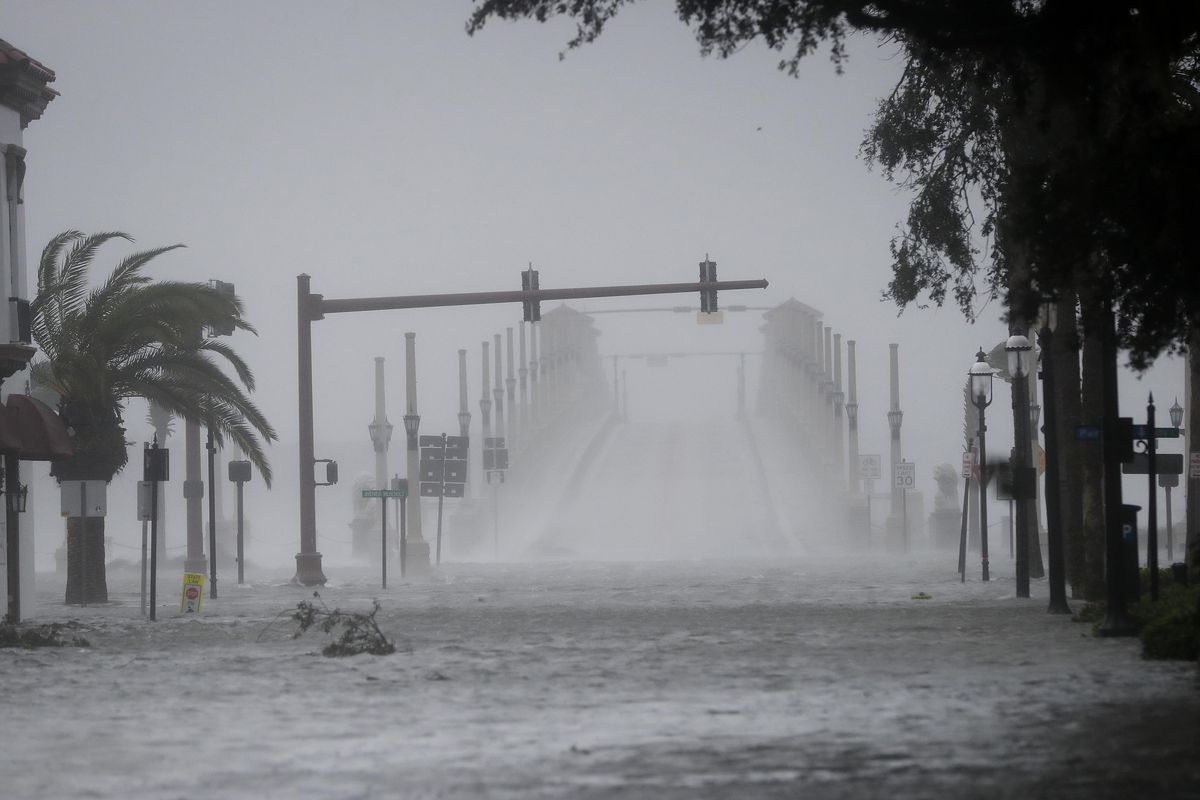Hurricane threatens some of South’s most storied cities
Noah Simons steers as his car is pushed out of flood waters caused by Hurricane Matthew, Friday, Oct. 7, 2016, in Daytona Beach, Fla. (Eric Gay / Associated Press)
ST. AUGUSTINE, Fla. – Hurricane Matthew spared Florida’s most heavily populated stretch from a catastrophic blow Friday but threatened some of the South’s most historic and picturesque cities with ruinous flooding and wind damage as it pushed its way up the coastline.
Among the cities in the crosshairs were St. Augustine, Florida; Savannah, Georgia; and Charleston, South Carolina.
“There are houses that will probably not ever be the same again or not even be there,” St. Augustine Mayor Nancy Shaver lamented as battleship-gray floodwaters coursed through the streets of the 451-year-old city founded by the Spanish.
Matthew – the most powerful hurricane to threaten the Atlantic Seaboard in over a decade – set off alarm as it closed in on the U.S., having left more than 300 people dead in Haiti.
In the end, it sideswiped Florida’s Atlantic coast early Friday, swamping streets, toppling trees onto homes and knocking out power to more than 1 million people. But it stayed just far enough offshore to prevent major damage to cities like Miami, Fort Lauderdale and West Palm Beach. And the coast never felt the full force of its 120 mph winds.
“It looks like we’ve dodged a bullet,” said Rep. Patrick Murphy, a Democrat whose district includes Martin County, just north of West Palm Beach.
At least four people died in Florida. An elderly St. Lucie County couple died from carbon monoxide fumes while running a generator in their garage and two women were killed in separate events when trees fell on a home and a camper.
While the hurricane was weakening quickly, several northeastern Florida cities, including Jacksonville, were still in harm’s way, along with communities farther up the coast. Authorities warned that not only could Matthew easily turn toward land, it could also cause deadly flooding with its surge of seawater.
The storm gouged out several large sections of the coastal A1A highway north of Daytona Beach, and had nearly completely washed out the northbound lane for about a mile at Flagler Beach.
“It’s pretty bad, it’s jagged all over the place,” said Oliver Shields, whose two-story house is within sight of the highway.
About 500,000 people were under evacuation orders in the Jacksonville area, along with another half-million on the Georgia coast. More than 300,000 fled their homes in South Carolina. The latest forecast showed the storm could also scrape the North Carolina coast.
“If you’re hoping it’s just going to pass far enough offshore that this isn’t a problem anymore – that is a very, very big mistake that you could make that could cost you your life,” National Hurricane Center Director Rick Knabb warned.
St. Augustine, which is the nation’s oldest permanently occupied European settlement and includes a 17th-century Spanish fortress and many historic homes turned into bed-and-breakfasts, was awash in rain and seawater that authorities said could top 8 feet.
“It’s a really serious devastating situation,” the mayor of the city of 14,000 said. “The flooding is just going to get higher and higher and higher.”
Historic downtown Charleston, usually bustling with tourists who flock to see the city’s beautifully maintained antebellum homes, was eerily quiet, with many stores and shops boarded up with plywood and protected by stacks of sandbags.
The city announced a midnight-to-6 a.m. curfew Saturday, around the time the coast was expected to take the brunt of the storm.
Matthew’s outer bands began lashing Savannah, a city that was settled in 1733 and has a handsome historic district of moss-draped trees, brick and cobblestone streets, Greek Revival mansions and other 18th- and 19th-century homes.
Matthew was expected to bring winds of 50 to 60 mph that could snap branches from the burly live oaks and damage the historic homes. And 8 to 14 inches of rain could bring some street flooding.
Savannah-Chatham County Police Chief Jack Lumpkin said officers will enforce a dusk-until-dawn curfew.
Airlines canceled at least 5,000 flights Wednesday through Saturday, including many in and out of Orlando, where all three of the resort city’s world-famous theme parks – Walt Disney World, Universal Studios and SeaWorld – closed because of the storm.
But things began getting back to normal, with flights resuming in Miami and other South Florida airports.
In areas the storm had already passed, residents and officials began to assess the damage.
Robert Tyler had feared the storm surge would flood his street two blocks from the Cape Canaveral beach. Tree branches fell, he could hear transformers exploding overnight, and the windows seemed as if they were about to blow in, despite the plywood over them.
But in the morning, there wasn’t much water, his home didn’t appear to be damaged on first inspection, and his vehicles were unharmed.
“Overnight, it was scary as heck,” Tyler said. “That description of a freight train is pretty accurate.”
Mohr reported from Orlando, Florida; Gary Fineout in Tallahassee, Florida; Kelli Kennedy and Terry Spencer in Fort Lauderdale, Florida; Jennifer Kay, Freida Frisaro and Curt Anderson in Miami; Marcia Dunn in Cape Canaveral, Florida; Janelle Cogan in Orlando, Florida; Russ Bynum in Savannah, Georgia; Martha Waggoner in Raleigh, North Carolina; Jeffrey Collins on Hilton Head Island, South Carolina; Jack Jones and Meg Kinnard in Columbia, South Carolina; and Bruce Smith in Charleston, South Carolina, contributed to this report.


